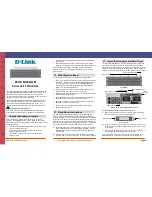
CONFIGURATION INSTRUCTIONS
The NV-ER18016i TBus receiver hub delivers high bandwidth encrypted Ethernet signals over virtually any kind of wire (Coax, UTP, STP,
Un-twisted wire, etc.). To provide utmost signal integrity and security, the NV-ER1808i receiver
must be configured
to communicate
exclusively with other transceivers within their
TBus Network Group
. This group typically consists of one or more remote Transmitters,
typically located at the IP camera and one Receiver, typically located at the controlroom. Transmitters may be the NV-ET1801 or NV-ET1804.
The Receiver may be the NV-ET1801, NV-ER1804, NV-ER1808i, or NV-ER1816i.
Before functioning on the network,
each NV-ER1816i must learn which other transceivers are to be part of that group
. This simple
process is called Joining. It is recommended that transceivers in each Network Group be configured
prior to deployment
using these
instructions:
Step One: Gather Materials
• All 1800 series Transceivers
• Device labels
• RJ45 patch-cord
• IP Network Documentation Log
• Small paper-clip, partially straightened
Step Two: Connect Hardware
• Remove and discard the “Configure Before Use” labels.
• Use an RJ45 or BNC patch-cord to connect the TBus ports of two Transceivers.
CAUTION: Never connect the RJ45 TBus port to an RJ45 ethernet port
.
• Apply power to the Hub.
• The blue POWER LED on each Transceiver will blink for 8 seconds and then go on.
• After 20 seconds, verify that the green TBus Link LED on each transceiver is off.
If a TBus Link LED is on, the Transceiver has been previously joined.
Perform the un-joining process below before proceeding.
Step Three: Joining
• On Transceiver #1, using the straightened paper-clip, momentarily depress
and release the small JOIN push-button located on the bottom of the unit.
Its blue Power LED will begin blinking.
• Depress and release the same push-button on the Transceiver #2.
Its blue Power LED will begin blinking.
(The NV-ER1816i also has a web browser-based Join button.)
• Both Transceivers have now entered
Join Mode
.
They will find each other and establish encrypted communication.
In about 10 seconds, the blue Power LEDs on both Transceivers
will return to a steady on condition, and their green TBus Link LEDs
will illuminate, indicating a successful
Join
.
• One TBus Link LED will remain on solid. The other may wink with data.
Step Four: Adding Transceivers
(if required)
• Disconnect Transceiver #1 and replace it with a new un-joined Transceiver.
• Repeat steps two and three to add additional Transceivers to the same Network Group.
Step Five: Documentation
• Label the configured Transceivers with a unique Network Group ID of your choice.
This will help you identify them after they have been deployed.
• Record this Network Group information in your IP Network Documentation Log:
• Camera Number
• Camera-end NVT Transceiver MAC Address
• Camera Position/Location
• NVT Transceiver Network Group Name
• Camera Make & Model
• Control Room NVT Transceiver MAC Address
• Camera MAC & IP Address
• Control Room Router Port Number
• Camera Login & Password
This log may include essential documentation which will help you identify all
system devices during and after deployment. The NV-ER1808i has data
entry fields for this purpose.
Un-Joining a Transceiver
If you need to move a Transceiver from one Network Group to another, it must first un-learn its
previous Network Group and be returned to an un-joined state. Do this by:
• Apply power.
• The blue POWER LED on each Transceiver will blink for 8 seconds and then go on.
• Using the straightened paper-clip, depress the small JOIN push-button until the blue Power LED goes off (about 13 seconds).
• Un-joining is now complete.
If you are not sure that un-joining has been successful, remove and then re-apply power, and repeat.
Page 3 of 25
10/
100
PoE+
56V
DC
NO
AN
ALOG
OU
TPU
TS: 56
VD
C
1A
MP
MA
X.
P
ER P
OR
T
(no analog / no ethernet)
USE ON
LY
WITH A 250V FUSE
J
oi
n
B
u
tt
o
n
Transceiver #1
Transceiver #2
Join B
utto
n
Transceiver #1
Transceiver #2
Join B
utto
n
Join B
utto
n
OU
TP
UTS:
56VDC
1A
MP
MAX.
P
ER
PO
RT
(no analog / no ether
net)
USE ONL
Y
WITH A 250V FUSE
This device complies
with Part 15 of
the FCC Rules.
Operation is su
bject to the fol
lowing two condi
tions:
(1) This device
may not cause har
mful interference
,
and (2) this de
vice must accept any
interference
received, including i
nterference th
at may cause
undesired opera
tion.
0.03 MIN. 1.6A M
AX.
DO NOT EXCEED T
WO POWER SUPPL
IES PER SYSTEM
PoE
Join
Butt
on



































